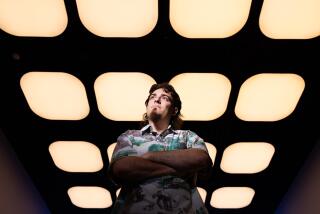Lockheed-California Flying High : Emphasis on Military Contracts Turns Firm Around
When Lockheed announced in December, 1981, that it would phase out its L-1011 TriStar jetliner, the unit that made the plane--Burbank-based Lockheed California Co.--was in deep financial trouble.
But several years later, with the money-losing project completed, Lockheed-California is the second-most profitable Lockheed unit, one analyst said. According to the analyst’s report, the unit, which does not disclose its financial results, pulled in 15% to 20% of its parent company’s $8 billion in revenues in 1984 and made $180 million to $200 million in operating profit.
Lockheed-California turned its performance around by concentrating on making warplanes and pulling out of the more volatile commercial aircraft business.
‘Market Has to Be There’
“We haven’t ruled out the possibility of making commercial airplanes again,” said E. Lloyd Graham, executive vice president at Lockheed-California. “But the market has to be there to sustain production. What makes us profitable is making lots of military planes which go for tens of millions of dollars each.”
There is less risk in military contracts than in commercial ones, analysts say. In military projects, a company is traditionally reimbursed for research and development costs. Most passenger plane projects lose money, in part because the company pays those expenses.
Lockheed-California has relied on its 40-year-old niche in anti-submarine patrol aircraft and its 30 years of experience making high-altitude reconnaissance planes.
Analysts say that its Advanced Development Projects program, or “Skunk Works,” named for the foul odor from a plastics factory that permeated the tents of the program’s first operation in 1943, is working on a stealth fighter plane, one that is designed to elude detection by radar. The project will be a big moneymaker, they predict.
Manufacturing civilian aircraft is “a stinko business,” said Wolfgang H. Demisch, who follows the defense industry for First Boston Corp. in New York. He estimates that of 30 commercial airplanes manufactured since World War II by companies around the world, only three have been profitable. The research and development costs are high and, contrasted with the automotive industry, the demand stays relatively low, he said.
Building military jets is not always a predictable business, either. Governments sometimes cut back or cancel their orders. But few military planes have been financial dogs, and the defense industry is virtually recession-proof.
Analysts’ Comments
“Government keeps spending money regardless of whether the economy goes up or down,” said L. Douglas Lee, a defense analyst for the Washington Analysis Corp., an independent economic and political research group.
Analysts say Lockheed-California has taken that lesson to heart. “I don’t think they’ll ever make a commercial plane again,” said David J. Smith, who follows the defense industry for Sanford C. Bernstein & Co., a New York brokerage.
When the last TriStar rolled off the manufacturing lines in August, 1983, Lockheed-California was able to cut its losses, as well as a quarter of its work force.
In 1980, nearly half of Lockheed-California’s sales came from non-military projects, mostly from the L-1011. More than 20,000 people worked for Lockheed-California in Burbank, and 5,000 more were in Palmdale.
Maintenance, Parts
Last year, just over 10% of the company’s business was non-miltary--mostly in the form of L-1011 parts production, maintenance and modifications for resold planes.
Lockheed-California employs 14,000 workers at the company’s 1920s-vintage complex in Burbank, making parts that include exterior panels, flooring and ribs for fuselages. Another 2,600 work at Lockheed-California’s Palmdale plant, completed in 1970 for the TriStar. Final assembly for all airplanes was transferred to Palmdale last September.
Nearly a thousand other Lockheed-California employees are at its Rye Canyon plant, near Valencia, and at a small subassembly plant in the Watts-Willowbrook section of Los Angeles.
Lockheed-California’s specialties are its search-and-destroy anti-submarine aircraft, including the P-3C Orion, which flies for the U.S. Navy. It also makes high-flying reconnaissance planes, including the successor to the U-2, the TR-1B, the first of which were delivered to the U.S. Air Force in 1983.
Radar Plane
The company is expanding into new areas as well. Last month, Lockheed-California displayed its airborne early warning and control aircraft at the Paris Air Show. A standard P-3 airplane with a saucer-shaped radar assembly on top, it is Lockheed-California’s answer to Boeing’s AWACS surveillance planes.
The company says that none has been sold yet, but it expects to receive orders for the plane by the end of the year.
Lockheed-California is also producing parts of the tail section for the giant C-5B military transport planes that started rolling out of Lockheed Georgia Co. facilities July 12.
Some other programs at the company are secret, such as projects at the Skunk Works.
Lockheed-California officials refuse to comment on rumors that the company is developing a stealth fighter plane, although analysts say it has already entered production.
Stealth Fighter
The Lockheed stealth fighter is not to be confused with the more widely publicized stealth bomber, which is being developed by Northrop.
A research report released in October by Sanford C. Bernstein & Co. predicted that the stealth program would generate $40 million in operating profit for Lockheed in 1984 and $130 million by 1988. By then, the report said, revenue for the plane would be $1.4 billion.
First Boston’s Demisch said secret or “black” projects “let engineers have more time to engineer. Costs are held down because there’s less bureaucratic paper work.”
Washington Analysis Corp.’s Lee said that not all secret operations are more profitable but that companies prefer them, anyway. “There’s no bad publicity when mistakes are made,” Lee said.
Inflated Prices
Lockheed-California’s Graham complained that too much attention has been given to the inflated prices reportedly paid for ashtrays and toilet seats for military planes.
“The total cost of 100 ashtrays at even $1,000 each is only $100,000,” Graham said, although he conceded the cost might serve as a symbol for critics of overspending.
Graham said military contracts are becoming more like commercial ones, increasing the risks to defense contractors. He cited the case of the C-5B, the transport plane built primarily by Lockheed-Georgia. Lockheed divisions had to foot the bill for some of the research and development costs, he said.
Lockheed-California’s L-188 Electra and L-1011 TriStar, its two civilian enterprises developed over the past 30 years, were both notable commercial flops.
Although the L-1011, which sold for $50 million to $70 million, is considered a very sound airplane, making it was a financial black hole for Lockheed-California, resulting in more than a $2.5-billion loss.
Overruns, Delays
The TriStar’s early problems included cost overruns and delays caused by the 1972 bankruptcy of Rolls Royce, the supplier of the aircraft’s engines. Production lines for the TriStar were shut down and 9,000 workers were laid off temporarily.
The delay gave McDonnell Douglas a lead in producing its DC-10, the wide-body, three-engine aircraft conceived about the same time as the TriStar, in the mid-1960s. Both planes were answers to Seattle-based Boeing’s Jumbo 747.
Lockheed-California officials say, and analysts agree, that the delay was the main reason DC-10s are still being made and L-1011s are not. Nevertheless, 250 TriStars were built between 1972 and 1983, and all but three are still operational.
The Electra, developed in the 1950s, had even less success than the TriStar. When it first appeared in 1959, it was a turboprop plane in a market that wanted jets. Sales remained sluggish.
Seven highly publicized crashes in less than three years of operation didn’t help matters. At least two of the accidents were attributed to a structural flaw in the plane known as “whirl mode,” damage or weakening of the plane’s engine mounts caused by hard landings, air turbulence and other factors.
The problems were corrected eventually. The basic Electra design is now used for the Navy P-3 that Lockheed-California is making in several versions. That slow but energy-efficient plane is modified into the new anti-submarine and surveillance planes.
More to Read
Inside the business of entertainment
The Wide Shot brings you news, analysis and insights on everything from streaming wars to production — and what it all means for the future.
You may occasionally receive promotional content from the Los Angeles Times.










